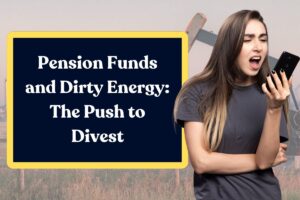With rising climate change we are seeing a significant change when it comes to the global investment strategies. The investors are actively moving away from fossil fuels and towards sustainable investing. Investing in green energy was once a niche idea. However, recently we are seeing that money is actively redirecting away from fossil fuels and toward clean, ethical, and climate-resilient alternatives.

Now this movement is not just about doing good but also about smart economics. In this blog, we will discuss how sustainable investing is changing traditional finance infrastructure, why divestment from fossil fuels is becoming important, and what’s next for investors committed to a livable future.
Why Divest from Fossil Fuels?
Before we have a discussion on what to do, it is important that we understand why we need to divest from fossil fuels.

1. The Climate Crisis
Fossil Fuels such as coal, oil, and natural gas are responsible for 80% of the global CO2 emissions around the world. Divesting from such resources is more than just a symbolic effort. It is an important financial decision that serves for a better low carbon economy.
By withdrawing their findings from the fossil fuel sector the investors are giving us a clear signal that the age of dirty energy will soon end.

2. Financial Risks of Stranded Assets
Currently, the governments around the world are actively working towards limiting global warming. Owing to these efforts a large portion of the fossil fuel reserve will soon become stranded assets, now these resources can never be extracted or used. Now the investors are actively exiting such industries who are heavily exposed to such assets.
3. Renewables Are Beating Fossils
If we look at the renewable energy side, we will find that the future of clean energy is good, also various studies have noted that the investments in the renewable energy sector is actively out performing the fossil fuel stocks.

For example, if you examine the markets in Germany and France, you will find that the renewable portfolio has surged by 178% in the past five years, whereas fossil fuel holdings have declined more than 20% in this time.
Global Momentum Behind Divestment
Over the past few decades we are seeing an increased momentum when it comes to disinvestment from fossil fuel projects. We have seen that in the last 10 years alone a total of 1,600 institutions have committed fossil fuel disinvestment. The total value of the disinvestment is over $40 trillion. The institutions include:

- Universities like Harvard and Stanford
- Pension funds such as ABP (Netherlands)
- Religious and philanthropic organizations
- Municipal funds like New York City and Seattle
Global Agreements Support the Shift
We have seen lots of international frameworks and agreements that further boost such disinvestments. Recently the Glasgow Statement that was adopted during the COP26 by the world, aimed at stopping the public funding of fossil fuels and diverting it to clean energy projects. Similarly, we have seen the Fossil Fuel Non-Proliferation Treaty, that calls for yeh global phase out of fossil fuel production.
Private Sector Realignment
We are not seeing changes only on the government side. The investors’ coalitions such as Climate Action 100+ have also made significant efforts in regards to the fossil fuel disinvestment. They have pressured the various oil giants like BP, Shell, and ExxonMobil to adopt climate action strategies.
Not only this we are seeing that the traditional banks and asset managers nowadays are also offering ESG funds, that does not include fossil fuel holdings.
How Capital is Being Redirected?
So now that we have seen that the world is actively shifting towards the more green investment, let’s see how they are walking out of the fossil fuel investments:
Strategic Divestment
The disinvestment strategies for different businesses may vary based on their approach. While some institutions are currently working towards fully divesting by selling their fossil fuel assets, others are going towards a slow phased approach, which will help them in reducing their exposure over time. Still others combine divestment with active ownership, using their shareholder power to demand climate action from companies
Reinvestment in Sustainable Alternatives
Disinvestment, doesn’t not just refer to taking your money out. It is a strategic process where you take money out of one place and invest it in the next place. So many investors are reinvesting their money in:
- Renewable energy projects
- Green bonds
- ESG-focused funds
- Sustainable infrastructure
If we talk about 2023, you will see that the global energy investment hit $2.8 trillion, with nearly $1.7 trillion going into clean energy. This particular trend has outpaced the fossil fuel trend for the first time in history.
Tech and Transparency
With modern tools like AI and Block chain we have moved towards an environment with more transparency and risk analysis. With these technologies investors are now able to avoid green washing and make informed decisions about where to put their money.
So, till now you must have understood that sustainable investing has become more than just a trend, it is a necessity now. Redirecting your capital away from fossil fuels is a powerful and bold strategy. It involves climate responsibility, financial foresight, and social impact. Now that more investment is flowing towards clean energy as compared to fossil fuels, we are seeing a significant market transformation.
Even though we have made significant strides in regards to investment, the battle against climate change is far from over. Currently, institutions, investors and the governments are working together to ensure that money not only grows together, but also grows sustainably.






